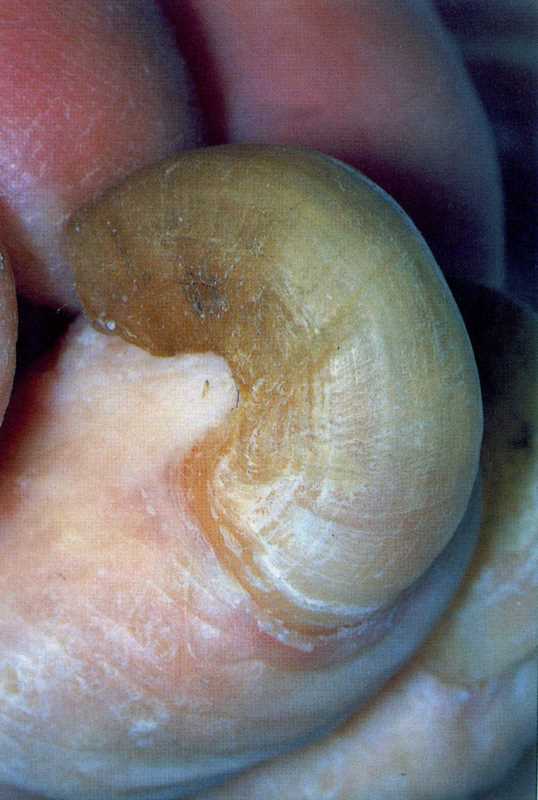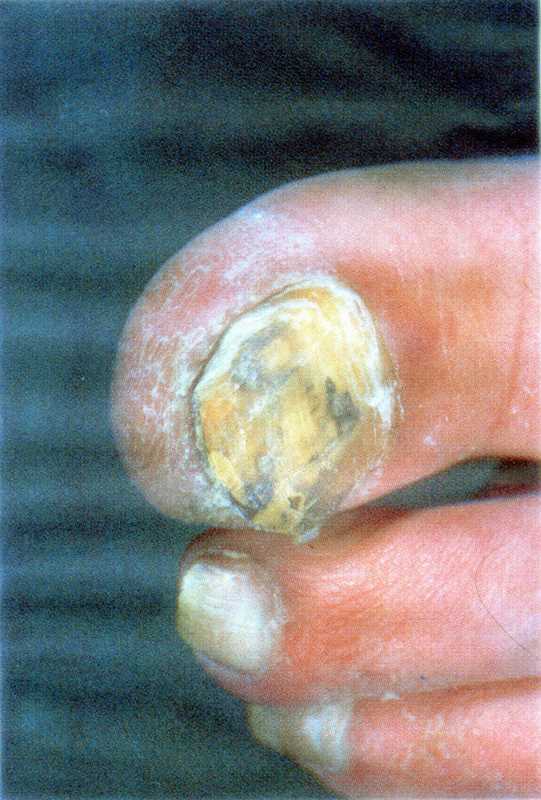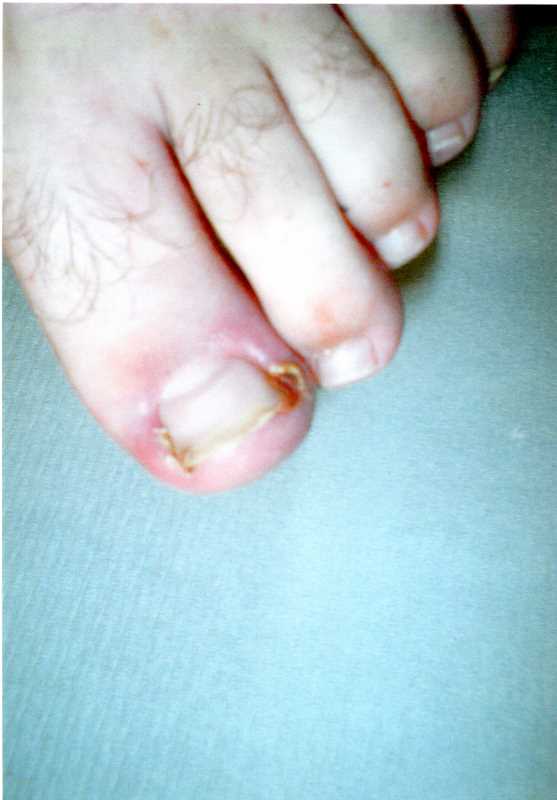Nail cutting advice
You should cut your nails following the natural curve at the end of the toe. There should be a small white length of nail left to protect the end of the toe.
You should not cut down the sides of the nail as you could leave a spike of nail which will grow forward and cause an ingrowing toenail.
If your nails are difficult to manage you should consult a professional for advice on the best way to manage them.
If you cannot reach or find it difficult to cut your nails you may find it easier to use a long file off the end of the nails rather than filing across them.
Deformed toenail
The most common reason for toenail to deform is injury. This may be from a single incident where something hit the nail or from repeated injury over time such as unsuitable footwear.
Sometimes a nail deformity can be congenital which means the deformity has been present since birth. A deformed nail could indicate infection (see fungal nail infection information).

A deformed nail, which is not caused by infection, is unlikely to be cured. A deformed nail can be managed by regular filing and correct cutting. Please see information on help with nail cutting.
A nail which is causing discomfort and cannot be managed through self care can be removed permanently (see nail surgery information).
If you are concerned about a deformed nail please seek advice from an HPC registered podiatrist who will be able to advise you.
Thick toenail
The most common reason for toenail to thicken is because of injury. This may be from a single incident where something hit the nail or from repetitive injury over time such as unsuitable footwear.
A thickened nail could indicate infection (see fungal nail). A thickened nail, which is not caused by infection, is unlikely to be cured. A thickened nail can be managed by regular filing to stop pressure problems in footwear. Please see information on help with nail cutting and filing.
A nail which is causing discomfort and cannot be managed through regular filing can be removed permanently (see nail surgery information).
If you are concerned about a thickened nail please seek advice from an HPC registered podiatrist who will be able to advise you.
Discoloured nails
Sometimes a nail can look discoloured because it is thickened. As extra thickness is added to the nail it is difficult to see the vascular pink nail bed and instead the nail looks yellow or pale. This kind of nail could be managed by filing or removal by an HPC registered podiatrist if troublesome.
The nail may have a fungal infection which is why it is discoloured. If infected the nail may also be brittle or a have a slight smell when up close (see fungal nail infection).
Your GP practice or podiatrist can send a clipping of your toenail to a microbiology department to identify if an infection is present. This would only be done if a health professional thought an infection was likely.
If an infection is present the nail could be left alone without treatment and just regularly filed. Be careful though as infection can spread to other nails or other family members if using the same nail cutting instruments.
It’s a good idea to have a separate file for the infected nail(s). A fungal infected nail can increase your risk of athlete’s foot which is a fungal skin infection. Please see athlete’s foot information for prevention.
Tablets can be prescribed by your GP to treat your nail infection. These tablets are very effective as they are able to reach parts of the nail which aren’t exposed.
However the tablets are not without side effects and may not be suitable for you. The tablets need to be taken for many months until the clear nail growth has fully grown through.
There are treatments you can by over the counter at the chemist, your pharmacist can advise you. Tea tree oil is known to be anti-fungal and when applied to the nail on a weekly basis it can help prevent the spread of infection.
You would need to apply until the nail has grown clear of infection and filing can help make the tea tree oil sink into the area better as well as removing some of the infection.
Fungal nail infection

If an infected nail is suspected, your GP practice or podiatrist can send a clipping of the toenail to a microbiology department to identify if an infection is present.
This would only be done if a health professional thought an infection was likely. Sometimes a thickened toenail is mistaken for a nail infection. Please see thickened nail information.
If an infection is present the nail could be left alone without treatment and just regularly filed. Be careful though as infection can spread to other nails or other family members if using the same nail cutting instruments.
It’s a good idea to have a separate file for infected nail. A fungal infected nail can increase your risk of athlete’s foot which is a fungal skin infection. Please see athlete’s foot information for prevention.
Tablets can be prescribed by your GP to treat your nail infection. These tablets are very effective as they are able to reach parts of the nail which aren’t exposed. However the tablets are not without side effects and may not be suitable for you.
The tablets need to be taken for many months until the clear nail growth has fully grown through.
There are treatments you can by over the counter at the chemist, your pharmacist can advise you. Tea tree oil is known to be anti-fungal and when applied to the nail on a weekly basis it can help prevent the spread of infection.
You would need to apply until the nail has grown clear of infection and filing can help make the Tea Tree oil sink into the area better as well as removing some of the infection.
What is an ingrowing toenail?
This occurs when the nail has been cut too short or down the sides leaving a sharp spike of nail. As the nail grows forward, this sharp piece of nail will dig into the skin at the side of the nail and eventually break the skin with resulting redness, pain, swelling and possible infection.
Ingrowing toenails are more common if the toebox of your shoes is too tight as the toes press together and cause pressure on the sides or the nails. If your feet are regularly hot and sweaty and the skin is soft it will be easier for the nail to penetrate the skin.
How to avoid the problem

- Do cut nails straight across following the natural contour of your nail.
- Do not cut down at the sides – the corners of the nail should be visible.
- Do not cut nails too short – the free white edge at the end of the nail should still be visible.
- Do file any sharp or rough edges.
What to do if the problem develops
- In the early stages when the toe is inflamed bathe the foot in warm salty water. Do this for three to five minutes. This helps to reduce the inflammation (swelling).
- Do not attempt to cut the nail.
- Dry the area carefully and apply a clean dressing.
- If the problem persists consult a podiatrist.
Nail surgery
If you have an ingrowing toenail which cannot be treated conservatively, you may need to have all or part of the nail removed under local anaesthetic. The nail bed is then treated with a chemical to stop the nail growing back.